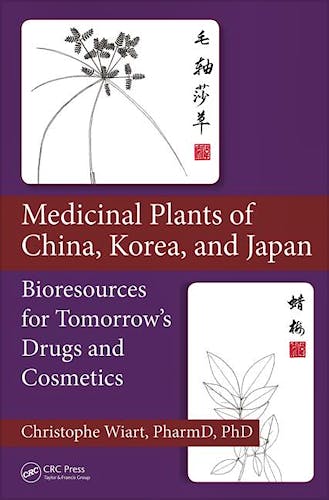

No hay productos en el carrito



Medicinal Plants of China, Korea, and Japan: Bioresources for Tomorrow’s Drugs and Cosmetics
Wiart, C.
1ª Edición Agosto 2012
Inglés
Tapa dura
454 pags
1000 gr
22 x 28 x 2 cm
ISBN 9781439899113
Editorial CRC PRESS
LIBRO IMPRESO
-5%
233,64 €221,96 €IVA incluido
224,65 €213,42 €IVA no incluido
Recíbelo en un plazo de
2 - 3 semanas
Description
Asian medicinal plants show great promise in pharmaceutical and cosmetological development. Researchers engaged in the discovery of new leads in these areas need robust conceptual tools and understanding of interrelated basics of botany, ethnobotany, biomolecular pharmacology, phytochemistry, and medicinal chemistry to guide their investigations. Medicinal Plants of China, Korea, and Japan: Bioresources for Tomorrow’s Drugs and Cosmetics explores the fundamental science and demonstrates the compelling potential of these versatile plants, providing an essential resource to stimulate and guide focused inquiry.
It is essential that researchers appreciate the chemotaxonomical statuses of these plants, so chapters are arranged according to the Angiosperm Phylogeny Group system of plant taxonomy. The book discusses the history, synonymy, habitat, description, traditional uses, and pharmacochemistry of each plant. Detailed photographs and hand-made botanical plates enable quick and reliable identification of each plant species. Critical analyses of peer-reviewed articles provide the basis for Bioresource sections in each chapter wherein readers are advised, engaged, and guided towards exciting pharmaceutical and cosmetological research proposals. Also included are indexes of botanical terms, pharmacological terms, natural products, and local names.
Detailing 200 medicinal plant species carefully selected for their novelty and pharmacological and cosmetological importance, this volume provides a firm starting point for anyone looking forward to unlocking the potential of Asian medicinal plants. In addition, this invaluable book identifies numerous patentable leads.
Features
- Provides robust conceptual tools and understanding of inter-correlated basics of botany, ethnopharmacology, biomolecular pharmacology, phytochemistry, and medicinal chemistry to guide researchers in appreciating, estimating, and forecasting the pharmacological or cosmetological value of medicinal plants
- Presents analyses of peer-reviewed articles that provide the basis for Bioresource sections in each chapter where readers are advised, engaged, and guided towards exiting pharmaceutical and cosmetological research proposals.
- Identifies numerous patentable pharmaceutical and cosmetological leads
Table of Contents
- Superorder Austrobaileyanae Doweld ex M.W. Chase & Reveal, 2009
- Order Austrobaileyales Takht. ex Reveal, 1992
- Family Schisandraceae Blume, 1830, nom. cons., the Schisandra Family
- Superorder Magnolianae Takht., 1967
- Order Piperales Bercht. & J.Presl, 1820
- Family Saururaceae E.F.Voigt (in L.C.M. Richard, 1811), nom. cons., the Lizard’s-tail Family
- Order Laurales Juss. ex Bercht. & J.Presl, 1820
- Family Calycanthaceae Lindl., 1819, nom. cons., the Strawberry Shrub Family
- Family Hernandiaceae Blume, 1826, nom. cons., the Hernandia Family
- Superorder Lilianae Takht., 1967
- Commelinids
- Order Commelinales Mirb. ex Bercht. & J.Presl, 1820
- Order Zingiberales Griseb., 1854
- Order Poales Small, 1903
- Non-Commelinids
- Order Asparagales Link, 1829
- Order Liliales Perleb, 1826
- Order Alismatales R.Br. ex Bercht. & J.Presl, 1820
- Superorder Ranunculanae Takht. ex Reveal, 1992
- Order Ranunculales Juss. ex Bercht. & J.Presl, 1820
- Family Ranunculaceae Juss., 1789, nom. cons., the Buttercup Family
- Family Lardizabalaceae R.Br., 1821, nom. cons., the Lardizabala Family
- Superorder Rosanae Takht., 1967
- Eurosids I
- Order Celastrales Link, 1829
- Order Fagales Engl., 1892
- Eurosids II
- Order Myrtales Juss. ex Bercht. & J.Presl, 1820
- Order Brassicales Bromhead, 1838
- Superorder Saxifraganae Reveal, 1994
- Order Saxifragales Bercht. & J.Presl, 1820
- Family Haloragaceae R.Br. (in M. Flinders, 1814), nom. cons., the Water Milfoil Family
- Superorder Santalanae Thorne ex Reveal, 1992
- Order Santalales R.Br. ex Bercht. & J.Presl, 1820
- Family Loranthaceae Juss., 1808, nom. cons., the Showy Mistletoe Family
- Superorder Caryophyllanae Takht., 1967
- Order Caryophyllales Juss. ex Bercht. & J.Presl, 1820
- Family Caryophyllaceae Juss., 1789, nom. cons., the Pink Family
- Family Droseraceae Salisb., 1808, nom. cons., the Sundew Family
- Superorder Asteranae Takht., 1967
- Order Ericales Bercht. & J.Presl, 1820
- Family Primulaceae Batsch ex. Borkh., 1797, nom. cons., the Primrose Family
- Euasterids I
- Order Garryales Mart., 1835
- Order Gentianales Juss. ex Bercht. & J.Presl, 1820
- Order Lamiales Bromhead, 1838
- Order Solanales Juss. ex Bercht. & J.Presl, 1820
- Euasterids II
- Order Asterales Link, 1829
- Order Apiales Nakai, 1930
- Order Dipsacales Juss. ex Bercht. & J.Presl., 1820
- Index
Author Bio(s)
Dr. Christophe Wiart has been studying the medicinal plants of China, Korea, Japan, Southeast Asia, and India for the last 16 years. He has collected, identified, and classified several hundred species of medicinal plants and is regarded as the most prominent authority in the field of Asian ethnopharmacology, chemotaxonomy, and ethnobotany. He is based in the School of Biomedical Sciences of the University of Nottingham and has authored numerous best-selling reference books on the medicinal plants of Asia.
© 2025 Axón Librería S.L.
2.149.0